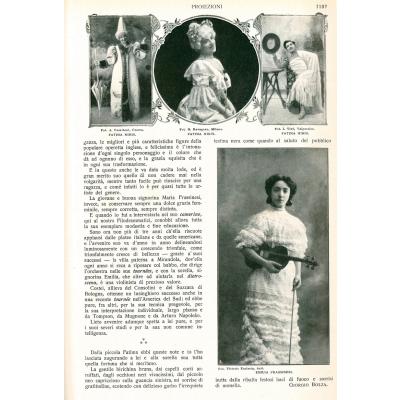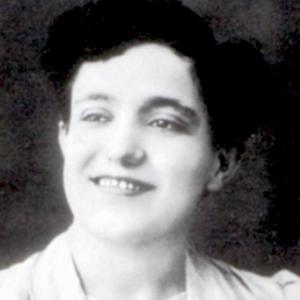Scheda
The adventurous life of Fatima Miris, who was considered a world-famous transformist artist during the beginning of the 20th century and who was also rich and adventurous, deserves a novel or a movie to be fully told. Maria Frassinesi(this was her real name) was the daughter of captain Arturo and the countess Anna Pullè, she was from Modena. She was born in Chiusa di Pesio(Cuneo) on 27th October 1882. In 1894 the family bought (or inherited) the wide west wing of the villa "La Personala", in Crocicchio Zeni, a town in the municipality of Mirandola (Modena).
The Frassinesi family lived permanently in Bologna and used to move to villa “La Personala” during summer. During the whole year the property was entrusted to tenant farmers such as Amedeo Garuti. Garuti’s son, Ivo,still remembers Maria-Fatima very well even today. “My grandfather Frandull, my father and my uncle used to work for the Frassinesi family, “masters" everyone was very fond of. Maria used to love living in her summer home, while during winter she had a very beautiful villa in Viale Aldini in Bologna. She had made her fortune thanks to her shows and everytime she returned home with her cart from Crocicchio Zeni to the station of Cividale, she used to bring with her a revolver. To my uncle, who was scared of weapons, she used to say: “you can’t trust anyone these days..”. As Monica Spelta reported some years ago in her essay published in the volume “Fatti e figura della Mirandola” (Al Barnardon edition), ever since she was a little girl, Maria Frassinesi had already revealed her unusual talents. She learnt how to play the violin and to sing with different voice timbres. As Simonetta Calzolari wrote (in an article published in 2009 in 'Indicatore mirandolese') Maria started performing staging domestic shows for family members, borrowing the clothes found in the house and impersonating different roles simultaneously. These were the "general rehearsal" of her capacity to transform, as she herself explained, of the ability to change numerous characters on the scene «with such a speed that the audience has the illusion of witnessing a representation made by several people». From a sailor to the main singer, from a clown to the priest and a geisha: she used to switch from one character to another, giving the impression that there were plenty of other actors participating in the show. This kind of show was becoming very popular during that time in Italy and to make it even more famous was none other than Leopoldo Fregoli, an actor born in a modest family in Rome who later became so famous worldwide to determine the birth of the term "fregolism" to indicate a prodigious rapid change in appearance.
Maria had such a strong and decisive personality that her father used to ironically call her “policeman”. Thanks to her stubbornness and her talent, Maria-Fatima succeeded in pursuing her dreams, to the point of establishing herself. The press used to define her as the "Fregoli in gonnella"- the female version of Fregoli (but at the time also the younger actress Tina Parri, competed for this nickname, and consequently, Parri was renamed "Fregolina"- the young female version of Fregoli). Despite the fact she had a teacher’s degree, she preferred to dedicate herself to the shows with the support of her father and the actor Emilio Zago, who wrote some comedies for her, among them "Ero and Leandro: a tragic, funny, sensational, musical comedy" set to music by Maestro Conte G. Bezzi. Her debut was in 1903, even though sources diverge on the day, it could have been on 7th September at the Teatro Brunetti (now called Duse) in Bologna or on 20th October at the Storchi in Modena. It was, however, the beginning of a dazzling career. The newspaper “Il Travaso” wrote about her performance at the Olympia in Rome in the year 1904, as the journalist stated: “This young lady who appears to be a boy, masquerades herself as Fatima Miris but in reality she is a revived Fregoli and fills every night the theatre of Nino Cruciali”. Her ability, combined with the knowledge of five foreign languages, took her abroad for long periods along with her sister Emilia, a skilled violinist. There were news everywhere of her crossing of the Amazon River with 63 huge trunks full of clothes, scenes and wigs or of her visit in Egypt during which she had the opportunity to meet the pashà Teofic and also of her friendship with the ambassador of Japan. Fatima Miris was an all-round artist. She also wrote a booklet ‘The hymn of Garibaldi: a monologue of transformations’, which was published in 1911 by Candido Grilli’s publishing company and is now in the central library of Florence.
As Giancarlo Petrini wrote in the volume ‘Il palcoscenico incantato’, Fatima Miris was specialized in four shows of operetta in which she played all the roles, masculine and feminine: The Merry Widow, The Geisha, The New Figaro and the Duchess of Bal Tabarin.” These were- the mirandolese artist explained in her diary- my pièce de résistance, but they were full of transformational difficulties and that cost me a huge effort in the performance. I played all the roles and all the characters with the respective duets, ballets, tenor novels, baritone… The public had an exact impression of the operetta being played by a full company of artists, it was faithfully performed and executed. Despite the vast repertoire, - continued Fatima Miris – What lacked, however, was a comedy that responded to what I wished for: I wanted the audience to be laughing but still in a constant tension for about twenty minutes, during which the audience itself had to be impressed by an amazing succession of transformations. In twenty four hours I wrote ‘The Marquise Divina’, a brilliant comedy, full of misunderstandings and comic situations. The characters were: the husband, the wife, the mother-in-law, the wife’s lover, the waitress, the cook, the coachman. The scene ended with a race, or better, with the general escape of all the characters, chased by a policeman, which, moreover, died in the worst of the way, because he was beheaded by a shot of the landlord’s revolver. The stampede was so hasty, so pressing for me and for all my dressmakers, that the audience, seized by a convulsive laugh, writhed, screamed and finally burst into thunderous applause, without even waiting for the curtain to fall. The scene was set in a salon sorrounded by transparent gauze walls. The light that illuminated them in the proscenium was very dim compared to the one which was inside, which illuminated the vestiarists in daylight, so that the public could easily realize what was happening between the scenes. Infact, while I was running my sister- or one of my collaborators- took off my pants with the help of another man, whose neck I hung, taking a leap, while the other helpers were stationed in the strategic points of the entrances and exits. Coming in the backstage, I used to get rid of the objects I had in my hand, throwing them in specific blankets that were lying on the ground, and I used to rush to meet the first group of my assistants, who quickly took off my wig and dress. The wigs, specially made for me , had already noses and mustaches attached on and, if necessary, beard and glasses, hat and hairstyle, depending on the dress worn by the character. Once freed from such garments, I hurried towards the second group of assistants, who used to wait for me with new clothes to wear».
At a certain point during her carrier Fatima Miris was also tempted by the cinema, or at least, as it would emerge from a letter published on the website of the association “Al Banardon”, she was enticed by someone who wanted to take advantage of her talent in order to realize a project(as far as we know, wrecked) to bring her talent into the big screen. It was 1914. The letter was signed by the editor of a well-known Neapolitan cinematographic magazine, "Film-Corriere settimanale dei cinematografi". Together with the congratulations for her «transoceanic successes», the director announced his next visit to the «splendid villa» of Crocicchio Zeni and also asked her to greet the «nice» father and the «kind» sister Emilia. In 1921 she was forced to interrupt her performances for a period, due to her father’s health problems. When she returned to Bologna she met Count Luigi d'Arco, whom she married the same year in the private oratory of Personala. The next year she had a daughter, Giovanna, who recently disappeared. She toured again for a few years and then retired to private life until 1932 when she returned to perform in South America, where the public had never forgotten her.
During the years of the Second World War, when she had already retired from the scenes, she lived permanently with her family in the villa of San Giacomo Roncole, because of the repeated bombings on Bologna. She died on 3 November 1954 in Bologna and is buried at the Certosa. One of her costumes from the shows is kept at the Civic Theatre Museum "Carlo Schmidl" in Trieste.
Traduzione realizzata nell'ambito del progetto di Alternanza scuola-lavoro 2020/21 con il Liceo Linguistico Boldrini di Bologna.







